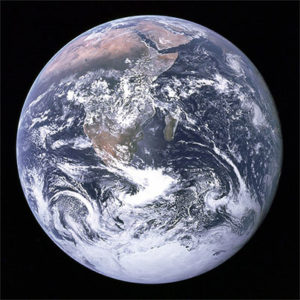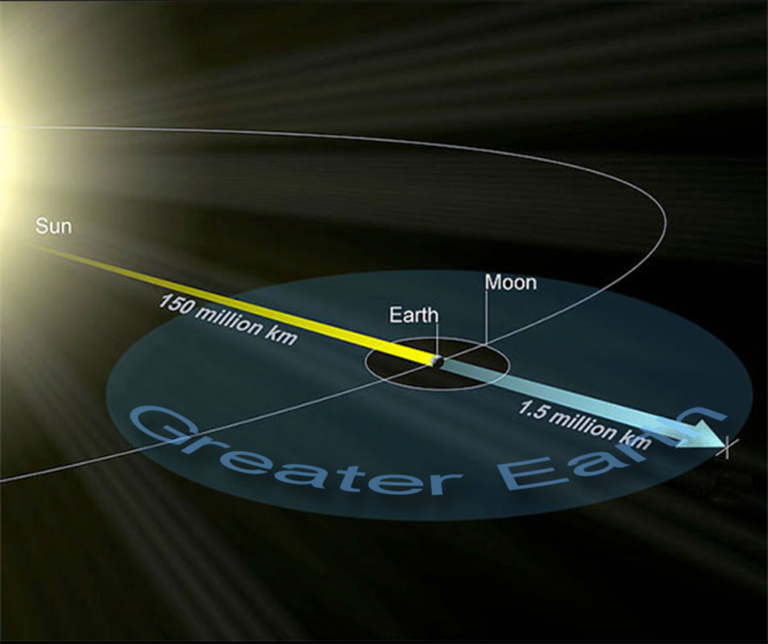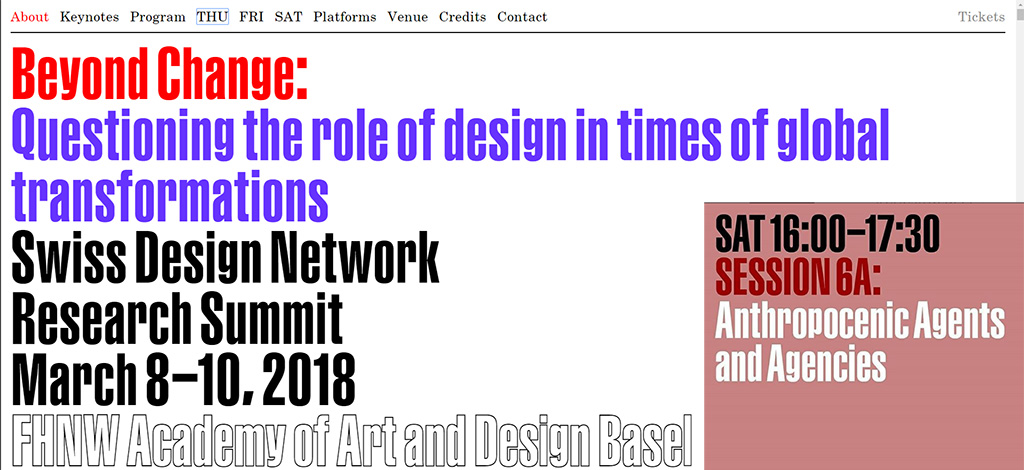Greater Earth – Redesigning our Planet
Arthur Woods / 06-03-2018
Video presentation at
Beyond Change: Questioning the role of design in times of global transformations
Swiss Design Network Research Summit
March 8–10, 2018
FHNW Academy of Art and Design Basel
The 14 min. video presentation depicts a virtual journey from the surface of Earth to the outer boundary of Greater Earth. The journey is narrated by resident artist/astronaut Arthur Woods. It begins with the launch of the “ars astronautica” spacecraft on a Sagan 3 launcher. Along the way, the video includes various computer animations which show the increasing population of space objects in Earth orbit from 1957 until now, a visit to the Moon, asteroid mining operations and ends at Lagrange point 1 where NASA’s DSCOVR - Deep Space Climate Observatory and its EPIC – Earth Polychromatic Imaging Camera are delivering a steady stream of images of our planet from the edge of Greater Earth.
Introduction
“You never change things by fighting the existing reality.
To change something, build a new model that makes the existing model obsolete.”
R. Buckminster Fuller [1]
Throughout millennia humanity has wondered about its relation to the cosmos and about its ultimate role and purpose in the matrix of life. Based on the available knowledge of the moment, different models of thought were created to try to satisfy its quest to find the answers to these fundamental existential questions. As knowledge increased though a process of making finer and finer discriminations about the nature of reality, the prevailing models of understanding were consequently modified or replaced by newer ones in order to have a more precise and believable explanation of where we came from, who we are and, ultimately, what is our purpose in the evolution of life.
Within this process, the perception of its home planet Earth has always influenced the way humanity has formulated its beliefs and conducted its affairs. When Earth was perceived of as the entire universe it gave rise to myths and religions that continue to permeate and influence society into the present time. With the advent of space exploration, humanity’s perception became that of the whole Earth - a living blue sphere floating in the vast expanses of the cosmos.

Photograph of Earth made by the Apollo 17 astronauts.
Today, most people are comfortable with the image of Earth as defined by the edges of its atmosphere which has become a powerful symbol of our times representing the environmental movements, the globalization of our diverse cultures and economies, and an understanding about the interdependence and interconnectedness of our climate and ecology.
It is a 20th century view of Earth and the majority of its inhabitants conduct their affairs accordingly. Not very different than our early ancestors, most our world leaders and probably most people alive today instinctively assume that whatever humanity's fate will be in the years ahead, it will be ultimately decided and enacted here on planet Earth and not anywhere else. Earth problems must surely have Earth solutions. However, this perception of our home planet is outdated and constraining. There is a need to formulate a new perception of planet Earth based on its true cosmic dimensions - a perception called Greater Earth [2] and how this new perception of our cosmic home can catalyze an optimistic path towards a sustainable and prosperous future for everyone on Earth.
Greater Earth - A New Perception of Our Planet
Some sixty years ago humans began to investigate ways to navigate beyond the atmosphere. Today a communications apparatus installed in Earth orbit permits us to remain in constant touch with each other from any place on the planet. Scientific instruments placed in this area are exploring the depths of the cosmos and investigating the state of the environment on the planet below. Orbital outposts are providing the information to enable human beings to adapt to this new environment. National security systems have placed monitoring devices that track developments and movements of opponents making surprise attacks less likely. Indeed, the functioning of contemporary society is totally dependent on these technological resources orbiting the Earth and without them modern civilization would no longer function.
These activities have effectively expanded the territory of planet Earth from its solid dimensions of 12,756 kilometers to a diameter of approximately 84,328 kilometers which encompasses geosynchronous orbit. As the 21st century unfolds, humanity finds that it needs more room and more resources to sustain its numbers and to maintain its thirst for further development. The finite planetary resources that contributed to its present state of development are being exhausted to unsustainable levels and their uncontrolled use within the biosphere is resulting in severe environmental, ecological and geopolitical consequences. As it is unequipped to occupy and transform a neighboring planet to meet its growing needs, humanity's next logical step will be to discover and inhabit the last reaches of its own planet - to expand its activities to Earth's true boundaries as defined by the laws of physics.

Greater Earth Diagram
All celestial bodies of significant concentrated mass exert a field of gravitational attraction around their cores which extends to the point of tangential intersection with other celestial bodies. [3] Earth's sphere of gravitational influence extends 1.5 million kilometers in all directions from its center where it meets the gravitational influence of the Sun. This sphere of influence (SOI) has 13 million times the volume of the physical Earth and through it, passes some more than 50,000 times the amount of solar power which is available on the surface of the planet. In addition to energy, within this sphere of 3 million kilometers are enormous amounts of other resources, including the Moon and occasional passing asteroids. Like the territorial waters surrounding nations, these resources belong to our planet and should efficiently be used for the ultimate benefit of humanity and all life which has originated here.
This is Greater Earth and within its boundaries our species will find the necessary room, resources and opportunities that it will need to survive and prosper in the current millennium. As it has throughout its history, humanity must again refine its perception of the planet in order to recognize and embrace an awareness of a greater, richer and more sustainable Earth. To do so, its next step is to exercise its fullest capabilities to occupy and enjoy this new territory. Undertaken responsibility and consequently, the severe pressures and stresses facing our civilization may be mitigated which may in turn lead to eventually achieving worldwide security, prosperity and ecological balance. [4] Furthermore, if one believes that economic and technological development are necessary preconditions for peace and prosperity, then one has to arrive at the conclusion that significant resources are necessary (a.) to fuel development, and (b.) to reduce tension. This tension-reducing potential is perhaps the greatest contribution to eventual peace and security on Earth.
The main advantages of Greater Earth include:
- Access to vital and plentiful new resources necessary to meet the growing needs of humanity, especially a source of unlimited clean solar energy
- A restoration of the terrestrial environment with sufficient clean energy
- A pollution sink for moving certain industries outside of the biosphere
- A lessening of political tensions as competition for the control of finite terrestrial resources diminishes
- Creating an infrastructure beyond the atmosphere may help provide a defense from possible impacts by asteroids and comets
- A new territory for human endeavors leading to new knowledge, skills and technologies
- Industrial development which would create many thousands of new skilled jobs on Earth which would stimulate the world economy
- The real possibility of creating an optimistic and prosperous future for the next generations
- Spreading and establishing life beyond the planet may insure its ultimate survival
Humanity’s Cosmic Choice
Of all the life forms sharing our home planet, the human species appears unique in that it alone can contemplate its existence, examine its past and look ahead to its future. Our species has also developed the means to look beyond Earth into the Universe. Until now, it has yet to find any hard evidence of life, as we know it, in other places beyond the Earth. Until such a discovery occurs, humanity must acknowledge that terrestrial life is not only rare but indeed may be unique. Thus, its role as the dominant species carries with it the responsibility to both nurture and further the conditions necessary for the survival and perpetuation of - not only its own species - but for all forms of life sharing the planet.
If one assumes that other technological civilizations have appeared throughout the cosmos, then one can speculate that they, too, must have faced a similar choice that confronts humanity at this particular moment. Did these distant civilizations decide to use their technology and knowledge to expand their civilization beyond their home planet in order to perpetuate their species, or did they misuse it and let their civilization and their future become destroyed? This situation represents the Cosmic Choice - a decision making process which any technological species must pass through at some critical point in its evolution.
Here on Earth, humanity has reached this decisive moment in its history. It has developed the technological means to leave its home planet and to begin operating in the environment beyond its atmosphere. On the other hand, this same technological capability could also be used in a negative manner in order to exert control over a majority of the population thereby limiting prosperity to a select few or, in the very worst case, be used to destroy human society and any chance of human expansion into the cosmos. Not only would this have serious consequences for humanity, but it may also prevent the ultimate survival of life in this part of the cosmos. Without space technology, life may never migrate beyond Earth and when the moment comes that our planet can no longer support life, then life on Earth will become extinct unless it had been planted elsewhere. [5]
In 1969, Gerard K. O’Neill, posed the following question [6]:
"Is a planetary surface the right place for an expanding technological civilization?"
This question concisely encapsulates humanity’s Cosmic Choice. An evolving technological species existing on a planet with finite resources is faced with the ultimate challenge of maintaining its development and the viability of its civilization before it reaches the threshold of unsustainability. In order to meet this challenge, it will need additional resources beyond those available to it on its planet's surface as well as an expanded environment that will stimulate the further development of its technological capabilities.
Two basic scenarios dominate today's discussions about humanity’s future. The Zero-Growth approach and the Business-as-Usual approach. Both of these approaches are at best inadequate attempts at mere survival which - however they might be packaged - not only will be ineffectual, but may eventually usher in dead-end, despotic and totalitarian regimes. Fortunately, there is another more optimistic approach called The Space Option which is to utilize resources located beyond Earth’s atmosphere for meeting the growing needs of humanity on Earth. [7] This approach offers a third version of the future, unspecialized, with many avenues, varied possibilities, with room for different kinds of development and the necessary material assets to at least attempt to realize them. As such, it grants humanity new horizons and a more hopeful future. The Space Option represents humanity’s Cosmic Choice.
The Anthropocene Era
“Awareness of ourselves as agents of geological change, once propagated and integrated, could provide us with the capacity to avoid doom and to take our future into our own hands.”
David Grinspoon [8]
Earth has always been the provider of raw materials and the mother of life. When humans were few Earth itself was the frontier to be discovered and explored. As exploration gave way to exploitation, the human species successfully established its dominance over the rest of nature and has since occupied the planet as no other species before it. It has devised means to extract and utilize terrestrial resources to feed its populous and to power its development. Our species has occupied the lands, farmed the vast oceans and traversed the skies in its quest for perpetual progress and development.
Today, there are more than 7.5 billion humans living, working and playing on a progressively crowded, environmentally stressed and ecologically endangered planet. Barring a major catastrophe, by the year 2050 there will be approximately 9 billion human beings [9] sharing the planet with the rest of life that has not by then been pushed to extinction by human expansion. We recognize that humanity has become the driving force of the major changes in Earth's environment and has created, what some call, the Anthropocene Era.
As Earth is the only home we know, and it's up to all humanity, working together, to make its home planet sustainable, not only for ourselves, but for all other living creatures who will come after us. If we do it right, the 21st century will not be the peak of human achievement, but rather our initial foray into an optimistic, uncertain but potential-rich future. The positive side of having so many people on Earth is that humanity has never experienced so much creativity and progress in such a short time. Therefore, appropriate to the Anthropocene Era, humanity itself must be considered as its most valuable resource and, in order to design a sustainable future, its overriding challenge is to find suitable ways to feed, clothe and otherwise nourish this precious resource without upsetting the social and ecological balance.
Thus, the arguments for expanding human civilization into the territory of Greater Earth appear overwhelming. In the past sixty years humanity has developed and demonstrated most of the necessary key technologies which has also catalyzed numerous other technological innovations and developments. Already, humans have been living continuously in orbital outposts for almost thirty years and have amassed both experience and knowledge about living in this harsh and unforgiving environment. The remaining technical obstacles associated with the development of Greater Earth are in reality mostly engineering challenges which could be met with sufficient commitment and resources.
The concept of Greater Earth is not utterly new as it builds upon work of space visionaries and pioneers such as Krafft Ehricke and Gerard K. O’Neill who recognized the eventuality that humanity must move beyond the atmosphere to survive and thrive. They and their followers developed both the scientific rationale and the technological capability to address the impending human dilemma. Krafft Ehricke called it the Extraterrestrial Imperative. [10]
In 1970 Ehricke wrote [11]:
"While civilization is more than a high material living standard, it is nevertheless based on material abundance. It does not thrive on abject poverty or in an atmosphere of resignation and hopelessness. It needs vigor as well as vision. Therefore the end objectives of solar system exploration are social objectives in the sense that they relate to, or are dictated by, present and future human needs."
Conclusion
As a proposal to redefine the perception of our planet, Greater Earth is a macro transitional and transformational design concept. Awareness of Greater Earth unites the ultimate potential of space development with the critical terrestrial issues of ecological sustainability, environmental restoration, clean energy generation, global prosperity, international security as well as the future evolution of life. Furthermore, it adds a needed cultural dimension to humanity’s space endeavors beyond their current integration in today’s society which operates mostly in the governmental and corporate domains. As such, Greater Earth challenges the prevailing perception of a finite planet Earth which is resulting in vast economic inequalities, environmental imbalances, declining personal freedoms and geopolitical conflict. Thus, as one of the main functions of art is to transmit understanding, it seems both appropriate and strategic to introduce the concept of Greater Earth into society’s discourse about its future on an artistic level.
References:
- 2016, Alex Ayres (Editor) Quotable Buckminster Fuller: An A-Z Glossary of Quotes from Buckminster Fuller, Quotable Wisdom Books , Kindle Location 248
- 1994, Elisa Griffin Wynn and Kevin Griffin, It is Greater Earth, Stupid, Space News, March 21, 1994 -http://greater.earth/about-the-name-greater-earth/
- Wikipedia: Sphere of Influence (SOI) https://en.wikipedia.org/wiki/Sphere_of_influence_(astrodynamics)
- 1998, Arthur Woods, Discovering Greater Earth, Paper presented at the Forum Engelberghttp://greater.earth/discovering-greater-earth/
- 2014, Arthur Woods, The Space Option: Our Cosmic Choice, Journal of Space Philosophy , Volume 3, Number 1 (Spring 2014) http://thespaceoption.com/overview_opinions_article.php?news_id=40
- 1975, Stewart Brand, "Is the surface of a planet really the right place for an expanding technological civilization?" - Interviewing Gerard O´Neill. pp 22-30. In: Stewart Brand, Ed (1977).Space Colonies. A CoEvolution Book/ Whole Earth Catalog/ Penguin Books
- 1993, Marco C. Bernasconi & Arthur R. Woods, Implementing the Space Option: Elaboration and Dissemination of a New Rationale For Space. (Part 1 & 2) - Paper IAA.8.1-93-764 a & b presented at the 44th International Astronautical Congress, Graz
http://thespaceoption.com/publications/Implementing_The_Space_Option_Part_1.pdf - 2016, David Grinspoon, Earth in Human Hands: Shaping Our Planet's Future, Grand Central Publishing, Kindle Location:166
- 2017, United Nation Global Population Prospects 2017
https://esa.un.org/unpd/wpp/ - 2009, Krafft Ehricke's Extraterrestrial Imperative, Krafft Ehricke, Marsha Freeman, Collector's Guide Publishing, Inc. (February 1, 2009)
- 1970, Krafft A. Ehricke. In-Depth Exploration of the Solar System and Its Utilization for the Benefit of Earth. Annals New York Academy of Sciences 187, 427-456.

